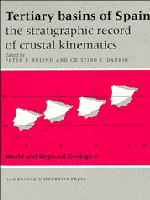Book contents
- Frontmatter
- Contents
- List of contributors
- Preface
- Dedication to Professor Oriol Riba IArderiu
- Memorial, Etienne Moissenet 1941–1994
- PART G GENERAL
- G1 Tertiary stages and ages, and some distinctive stratigraphic approaches
- G2 Cenozoic latitudes, positions and topography of the Iberian Peninsula
- G3 Tertiary tectonic framework of the Iberian Peninsula
- G4 Deep crustal expression of Tertiary basins in Spain
- G5 Oil and gas resources of the Tertiary basins of Spain
- G6 Mineral resources of the Tertiary deposits of Spain
- PART E EAST
- PART W WEST
- PART C CENTRE
- PART S SOUTH
- Index
G3 - Tertiary tectonic framework of the Iberian Peninsula
Published online by Cambridge University Press: 04 August 2010
- Frontmatter
- Contents
- List of contributors
- Preface
- Dedication to Professor Oriol Riba IArderiu
- Memorial, Etienne Moissenet 1941–1994
- PART G GENERAL
- G1 Tertiary stages and ages, and some distinctive stratigraphic approaches
- G2 Cenozoic latitudes, positions and topography of the Iberian Peninsula
- G3 Tertiary tectonic framework of the Iberian Peninsula
- G4 Deep crustal expression of Tertiary basins in Spain
- G5 Oil and gas resources of the Tertiary basins of Spain
- G6 Mineral resources of the Tertiary deposits of Spain
- PART E EAST
- PART W WEST
- PART C CENTRE
- PART S SOUTH
- Index
Summary
Abstract
During the Tertiary, Iberia was strongly deformed. It was located between the large EuroAsiatic and African plates, and was displaced east relative to the opening Atlantic, along with N–S convergence. During the Eocene, major compressional deformation occurred in the Pyrenees and Bay of Biscay, and this continued in the Oligocene. The opening of new basins in the Mediterranean led to the compression and formation of the Iberian Cordillera. The Betic–Riffian Internal zones, strongly deformed in the Palaeocene, were expelled westwards towards the end of the Oligocene and in the Neogene. In the Betic and Iberian Cordilleras, regional uplift with radial extension coexisted with N–S compression, starting in the Late Miocene. The interior of the Iberian massif, particularly the Spanish Central System, was also deformed under these regimes, and the inner basins were formed. The Ebro and Guadalquivir Basins were clearly foreland basins.
Introduction
The Iberian Peninsula has existed as a lithospheric plate located between the African and European plates (Fig. 1) throughout the Mesozoic and Tertiary. From the beginning of the Mesozoic until late in the Early Cretaceous its movements mainly coincided with those of Europe, whereas from that time to the Oligocene it moved together with Africa. Since the Oligocene or Early Miocene, the Iberian Peninsula has been joined to Europe (Malod, 1989).
- Type
- Chapter
- Information
- Tertiary Basins of SpainThe Stratigraphic Record of Crustal Kinematics, pp. 9 - 14Publisher: Cambridge University PressPrint publication year: 1996
- 14
- Cited by



